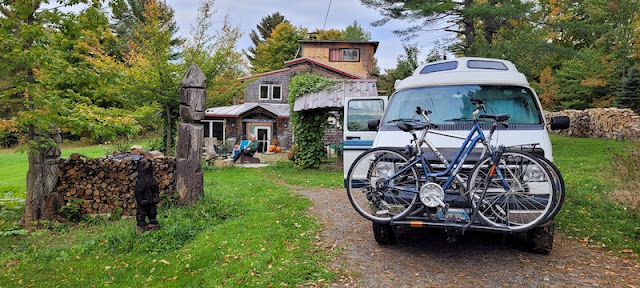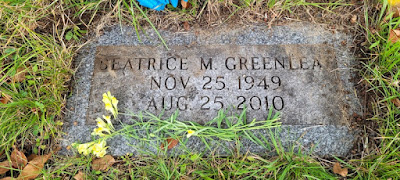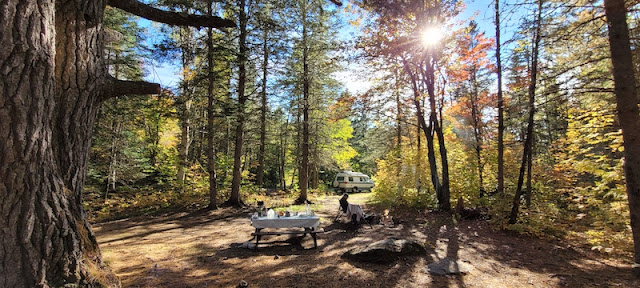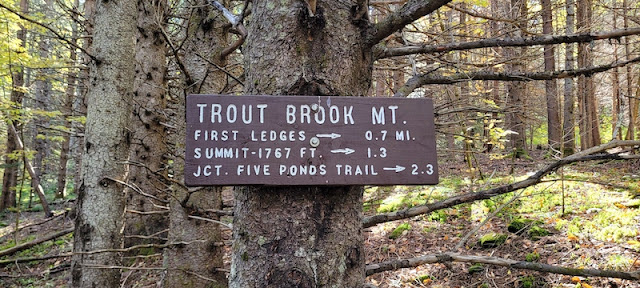October 1 - 5
My husband and I went on a New England fall foliage road trip in 2021. COVID, still a serious threat, was slowly working its way into the rearview mirror. The United States had withdrawn from Afghanistan, and Hurricane Ida was wreaking havoc along the East Coast. A good time to escape to the Great North Woods.
 |
The view of Mt. Katahdin from I-95 Scenic Overlook at Mile 252. |
 |
It feels good to be home again. |
I am from Maine, and we had many friends and family to visit along the way—including two friends from Juneau who also happened to be there. We set November 1 as our target departure date to avoid the possibility of running into snow. I have experienced Halloween snowstorms in the past.
This section of our trip was the most remote. We stocked plenty of fuel, food, and drinking water. There might be a day when that Luggable Loo would come in handy. (See the Vermont article about how we prepared for this trip.) Bethel was the perfect stop for reprovisioning. We found a parking space across from the Bethel Foodliner on Main Street. That was too easy.
Roger grew up near Sequoia and Yosemite National Park—one of the first national parks in the country, designated in 1890. Fortunately, naturalists recognized the need to protect the land from private development and set unique places aside “for the benefit and enjoyment of the people.”
During a drive through Shenandoah National Park a few years prior, we learned that city folk in New York, Boston, and Philadelphia also wanted to escape to the wilderness. Hence, the Park Service designated national parks in the East within a driving distance of major population centers.
 |
The North Woods offer expansive views of mountains and lakes. |
We have a fondness for state and national parks. Everyone can enjoy public lands in their natural state. Our current home in Southeast Alaska is part of the 17-million-acre Tongass National Forest. Public lands are accessible anywhere, anytime, without many restrictions due to special permission or permits. Contrast that to Maine, where 94% of Maine’s forests are privately owned. Fortunately, landowners in Maine provide public access to more than 10 million acres, often by permission or permit. (www.maine.gov, retrieved 9/22/2022)
 |
A woodpecker visits us on the trail. |
Unfortunately, my euphoric Maine high bubble burst after grocery shopping in Bethel when Roger tried to restart the van. Barely a click. Our first thought was a dead battery.
Yes, we were frustrated, but we were also grateful in hindsight. When you live on the road, you must accept a dead battery, a flat tire—a broken fuel pump! (see our Carlsbad, N.M., article)—can and will happen on any given day. What better place to have a dead battery than on Main Street in the middle of town and in front of a hardware store?
After unsuccessful attempts to fix the problem, Roger went to Brooks Bros. Hardware (fortuitously located next to us) and asked for help. A man who worked there came out and assessed the situation.
“I can see your problem right they-ah,” the man said in a thick Maine accent. He noticed that one of the terminal wires had come loose from the old clamp-style battery terminal, and after stripping and reattaching the wire, the van started with a quick jump from his truck. He adamantly refused any form of payment. Come to find out, he used to manage the local auto parts store for many years and now worked at the hardware store as a part-time retirement job, “to support my wife’s gardening habit,” he said.
 |
Steak dinner cooked on the open fire. |
Mt. Blue State Park Campground
Our next planned stop was originally Sugarloaf Golf Course and boondocking at the West Mountain golf course parking lot D or the Sugarloaf Outdoor Center. Information found online described both places as options, but both seemed iffy. I have learned from experience that I feel more comfortable with firmer plans.
 |
Starting to feel the cool fall weather at Mt. Blue State Park Campground. |
Boondocking at Sugarloaf would have been adventurous and van-lifey, but we changed our minds and continued to Mt. Blue State Park Campground in Weld, a natural stop for RVers traveling from The White Mountains in New Hampshire to Acadia National Park in Maine. Of all the places on this trip, Mt. Blue is where I would have spent more time.
 |
Our route through Western Maine. |
Mt. Blue State Park and the surrounding Tumbledown Public Lands deserve to be a destination by itself. The state park encompasses 8,000 square miles. The adjoining public lands add 22,000 acres. Ice sheets sculpted this land between 18,000 and 14,000 years ago, leaving behind mountains, valleys, rocks, and lakes. Seven major hiking and more accessible nature trails include the popular and challenging Tumbledown Loop Trail at 3,068 feet.
 |
Roger fried burritos for dinner. |
The campground is located on the opposite shore of Webb Lake from the state park, with access via West Side Road. (If you go, pay attention. We missed the turn the first time.) We arrived during the first-come, first-serve off-season and had no problem finding a site. A group of campers near us were traveling together and having a good time. The rest of the campground was quiet, and the chilly evening air called for a fire.
Lakewood Golf Course
(NOTE: On some days, we put our phones away and take a break from photos. Neither Roger nor I took pictures at the golf course. We must have been tired! Enjoy these photos from Brighton Farm.)
 We left Mt. Blue the following day and headed toward Skowhegan, where we had a tee time at Lakewood Golf Course in Madison. The area had experienced heavy rains before our arrival, and the course was soggy. Course challenges included “natural pollinator habitats,” with a penalty for searching for your ball in this area of tall grass and wildflowers. Was this the golf course’s clever way of warning against bee stings?
We left Mt. Blue the following day and headed toward Skowhegan, where we had a tee time at Lakewood Golf Course in Madison. The area had experienced heavy rains before our arrival, and the course was soggy. Course challenges included “natural pollinator habitats,” with a penalty for searching for your ball in this area of tall grass and wildflowers. Was this the golf course’s clever way of warning against bee stings?Modest homes with backyard gardens, apple trees, and chicken coops lined the fairway. One house had a “No Trespassing” sign and a rack of golf balls for sale in the backyard.
A unique aspect of this course was the par-six on hole 12. I had just about given up by then. I was cold, tired, hungry, and had wet feet. After nine strokes, I picked up my ball, still a reasonable distance from the pin. Roger got it in on nine. Most of the other holes were par-four, with four par-threes and two par-fives.
On top of the poor conditions of the golf course, we received disturbing news while still on the course. Text messages from friends and family in Juneau alerted us to a micro-burst wind storm that blew through our neighborhood and felled a large tree on our property, missing our house by inches. A branch hit the side of the deck and broke a railing, and the tree scrubbed the side of the house, pulling off the utility connections.
Roger has the best logistical skills of anyone I know, and in a short time, he made the necessary calls to get the immediate damage cleaned up and the utilities repaired. With the help of family and friends, we could continue our trip and deal with the rest when we returned home in mid-November, knowing that our summer fish in the freezer was safe.
Friends invited us to boondock on their farm in Brighton that night. What a sight for sore eyes. They built their home and developed the organic farm themselves over many years. The details in the house and garden revealed their creativity. The farm’s groovy vibe relieved the stress of worrying about our home in Juneau.
 |
"The Road to a Friend's House is Never Long" |
We sat outside and visited amidst baskets of recently harvested vegetables and pots of overflowing marigolds and climbing mandevilla. We ate a harvest dinner and retired to the van with bellies full and minds stimulated from reminiscing.
 |
Brighton Farm provided a peaceful respite from the road. |
I arose early to join my friend outside for sunrise coffee. He said he has sunrise coffee on the stone patio every morning. “Can you believe we haven’t had a frost yet? The first week of October, and we haven’t had a frost in Maine. Unbelievable.” Tomatoes were still ripening on the vine, and he hoped the peaches on his tree would benefit from the late frost. Peaches are an unconventional fruit to grow in Maine, but as the climate changes, so do the gardening zones.
 |
Maine peaches ripening on the tree. |
You can find the Brighton Farm Group on Facebook. You can also listen to Bob Lovelace’s music at either Apple Music or on Spotify .
Later that morning, we met another group of friends at Coburn Park in Skowhegan for more coffee, doughnuts, and visiting. Relationships are often situational and fade away as time passes. I’m thankful these friendships have lasted, some going on 20+ years!
 |
A short detour in Madison to remember a friend. |
Baxter State Park
We had a long drive ahead of us, north on I-95 via Newport, Bangor, Orono, Old Town, Howland, Medway, Sherman, Staceyville, and Patten. A three-hour, 168-mile drive to Matagamon Gate, the northern entrance to Baxter State Park.
 |
The best photo we would get of Mt. Katahdin. |
Since we were not climbing Mt. Katahdin, we avoided the crowds of Appalachian Trail thru-hikers and leaf peepers and chose to stay at Trout Brook Farm Campground, site #27. We booked three nights, and although the Internet is full of warnings about RVs and vehicle requirements (“No vehicle over 9’ high, 7’ wide, or 22’ long”) entering the park, we had no problem. While our van was within their size requirements, we didn’t know how carefully they were going to measure. Our bike rack and bikes make the van a little longer than 20 feet.
 |
Site #27 at Trout Brook Farm Campground at Baxter State Park. |
Don’t get me wrong. Heed the warnings. This park belongs to Maine, and its minders are adamant about keeping it primitive. Besides, you wouldn’t want to drive an oversized vehicle or RV on the park’s narrow gravel Tote Road. From the gate to the campground was far enough for us.
 |
We accessed the trailhead across the street from the campground entrance. |
Baxter State Park has many rules you may not find at other campgrounds. The park provides a pdf copy of the regulations at BaxterStatePark.org. The Baxter State Park Facebook page is also helpful but can be confusing when commenters contradict each other. Call the park headquarters directly when in doubt and ask a park ranger.
 |
Beautiful view from Trout Brook Mountain. |
The park was peaceful, and we saw the most beautiful starry sky. During the day, we hiked Trout Mountain. We looked for Katahdin, but other peaks were in the way. Nevertheless, the overlooks opened up to views of the richest fall colors as far as the eye could see.
Cobscook Bay State Park Campground
The next leg of the journey took us from the mountains to the sea. To get there, we had another long day of driving on two-lane highways, backroads, and through small towns where the folks didn’t always act like the welcome committee. For example, when we pulled up to the Irving gas pump at Smith’s General Store in Springfield, a man in a pickup cut us off. He glared at us with an ugly eye and responded with an insult when Roger asked how to use this particular pump.
 |
Rest stop between Baxter and Cobscook. |
We live in Juneau, a tourist town, so we know what it’s like to have tourists crowding the stores, streets, and sidewalks. On this day, we got to feel the disdain of locals firsthand. Nothing we couldn’t shake off, but it reminded us that not everyone is as enamored with van life as we are.
 |
Foliage reflection in a quiet stream. |
Cobscook Bay State Park Campground is situated along the coast with campsites high above the water overlooking Cobscook Bay. We arrived during the off-season, first-come, first-serve status. Campers had already claimed the best waterfront sites when we got there, but we found one with a peek-a-boo view through the trees. The trees couldn’t filter out the smell of the clam flats in the morning. Ah! That fresh Maine air!
 |
The road we travelled by. |
We traveled down the coast of Maine during the next leg of our journey. That part we will share in the next installment of this blog. Stay tuned!
 |
Sunrise coffee at Cobscook Bay. |
Into My Own
By Robert Frost
One of my wishes is that those dark trees,From The Collected Poems of Robert Frost, Henry Holt and Company, Inc., 1930. Originally published in A Boy’s Will in 1913 by David Nutt, London.
So old and firm they scarcely show the breeze,
Were not, as ‘twere, the merest mask of gloom,
But stretched away unto the edge of doom.
I would not be withheld but that some day
Into their vastness I should steal away,
Fearless of ever finding open land,
Or highway where the slow wheel pours the sand.
I do not see why I should e’er turn back,
Or those should not set forth upon my track
To overtake me, who should miss me here
And long to know if still I held them dear.
They would not find me changed from him they knew—
Only more sure of all I thought was true.





No comments:
Post a Comment